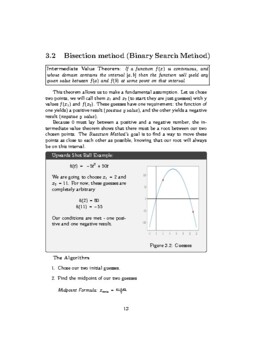Root Finding Algorithms - Numerical Methods - First few pages
- PDF
Description
This is the chapter on Root Finding Algorithms from a larger project I wrote: A Numerical Methods Companion for High School Mathematics, which intended to be an aid for teachers of 10th, 11th, and 12th grade math to introduce computer science concepts in a manner which parallels topics taught in a standard math curriculum.
Included in this PDF are the first few pages of a chapter that gives explanations for many root finding algorithms, including Bisection Method, Newton Method, and Secant Method, along with worked out examples, and sample Python code.
Since the 1970s, students have increasingly reached for graphing calculators or computers to find roots of equations, integrate functions, or evaluate derivatives. However, while many of the problems that are found in high school textbooks can be solved by calculators (or computers), the methods that computers use are distinctly different than the methods used on the blackboard, and what is happening on the computer chip can be fascinating math in its own right.
While this book does not replace the analytical methods used in the class- room, the study of these algorithms (a branch of computer science known as numerical methods) will allow high school students to approach the math from a novel manner, thereby increasing their understanding, as well as introduce computer science and programming.
Though designed as a coherent curriculum, each chapter can be used as a standalone resource. A basic background in computer programming is necessary (mainly a fluency in defining functions, and working with variables and loops). The examples in this book are all written in Python, with Numpy and MatPlotLib used for matrices and graphing. These are standard and free programs that have been a mainstay for well over a decade. However, the theory is universal, and can be done in any programming language or with a large variety of tools. Google’s Colab gives a very easy simple platform with which to begin exercises in this book.





